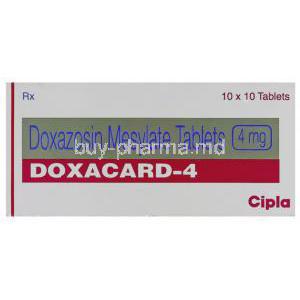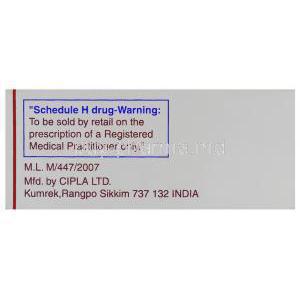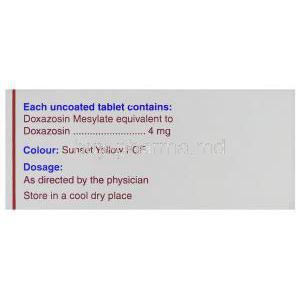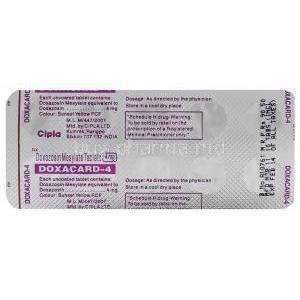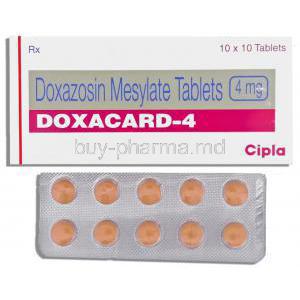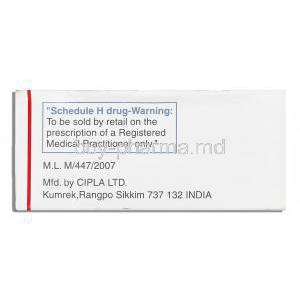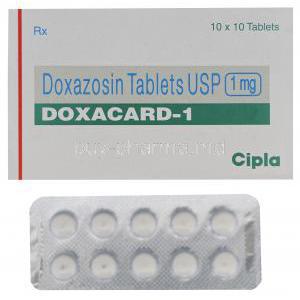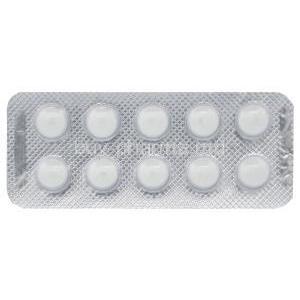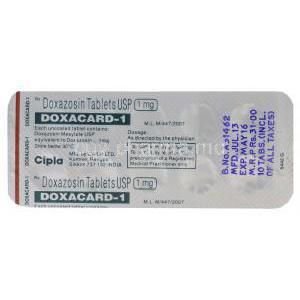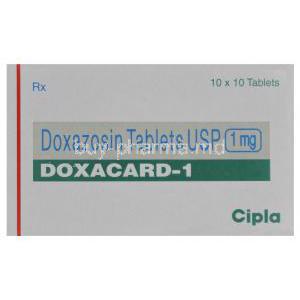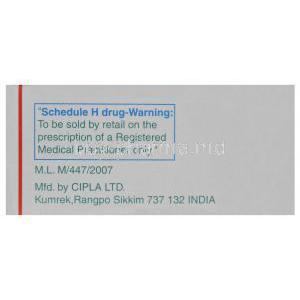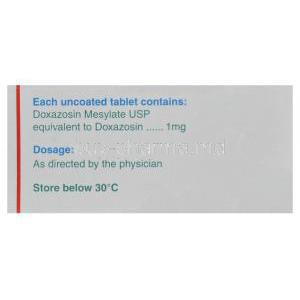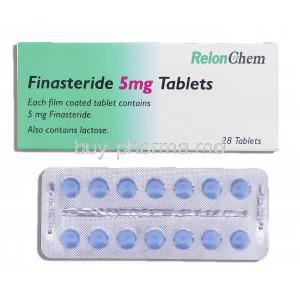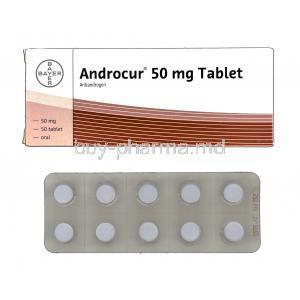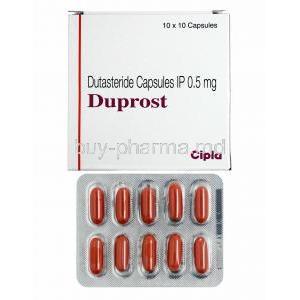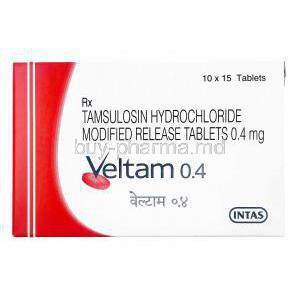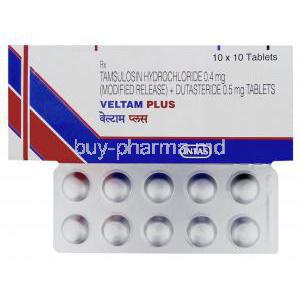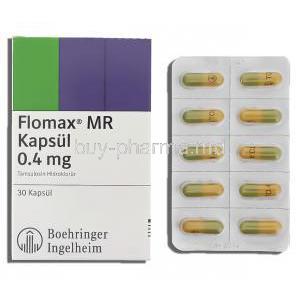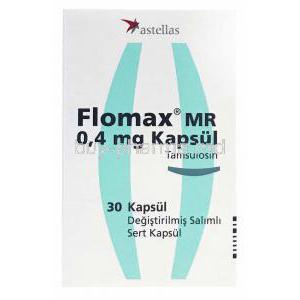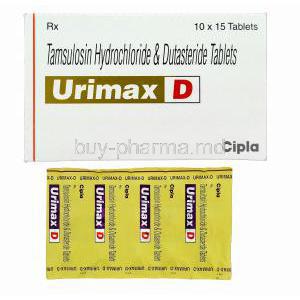Introduction to Doxacard (Doxazosin Mesylate)
Overview of Doxacard as an Alpha-1 Adrenergic Receptor Blocker
Doxacard, containing the active substance Doxazosin Mesylate, belongs to the pharmacological group known as alpha-1 adrenergic receptor antagonists. By selectively inhibiting alpha-1 receptors in vascular smooth muscle and the prostate gland, it provides therapeutic benefits in both cardiovascular and urological conditions.
Historical Development and Approval Status
The compound was developed in the late 20th century as part of the search for effective antihypertensives with added urological benefits. Over time, regulatory agencies approved its use for hypertension and benign prostatic hyperplasia, solidifying its position as a dual-utility medication.
Therapeutic Classification and Relevance
Doxacard is classified as both an antihypertensive and a urologic agent. Its role in managing systemic blood pressure, as well as relieving urinary obstruction caused by an enlarged prostate, makes it invaluable in geriatric medicine and chronic disease management.
Composition and Formulation
Active Ingredient: Doxazosin Mesylate
The core therapeutic component is Doxazosin Mesylate, a quinazoline derivative with potent receptor-blocking capabilities.
Available Strengths and Dosage Forms
- Immediate-release tablets in 1 mg, 2 mg, and 4 mg strengths
- Extended-release formulations designed for once-daily dosing
Inactive Ingredients and Excipients
Each tablet contains stabilizers, binders, and fillers such as lactose, cellulose derivatives, and magnesium stearate to ensure consistency, absorption, and long-term stability.
Mechanism of Action: How Doxacard Works
Alpha-1 Adrenergic Receptor Antagonism Explained
Doxacard functions by inhibiting alpha-1 adrenergic receptors, which are responsible for mediating smooth muscle contraction in arteries, veins, and the prostate.
Effects on Vascular Smooth Muscle and Blood Pressure Reduction
Through receptor blockade, vascular resistance is diminished, resulting in reduced blood pressure. This mechanism also enhances blood flow and alleviates the burden on the cardiovascular system.
Impact on Bladder Neck and Prostate Relaxation
By relaxing the muscles around the bladder neck and prostate gland, Doxacard improves urinary flow and reduces obstructive symptoms associated with benign prostatic hyperplasia.
Pharmacodynamics and Onset of Action
The onset of action typically occurs within hours of administration, with peak plasma concentrations observed between 2–3 hours for immediate-release forms. Extended-release formulations provide a steady therapeutic effect throughout the day.
Clinical Uses of Doxacard
Approved Medical Uses
- Treatment of hypertension: Effective as monotherapy or in combination with other antihypertensive agents.
- Management of benign prostatic hyperplasia: Relieves lower urinary tract symptoms, enhancing quality of life.
Off-Label Uses
- Congestive heart failure: Occasionally used as an adjunct to standard therapies.
- Raynaud’s phenomenon: Improves peripheral blood flow by reducing vasospasm.
- Ureteral stone expulsion: Facilitates stone passage through smooth muscle relaxation.
- PTSD-related nightmares: Investigated for improving sleep quality in post-traumatic stress disorder.
- Pheochromocytoma management: Used adjunctively in controlling paroxysmal hypertension.
Dosage and Administration Guidelines
Standard Adult Dosage for Hypertension
Initial dose is typically 1 mg once daily, gradually titrated to 2–8 mg depending on patient response and tolerance.
Standard Adult Dosage for Benign Prostatic Hyperplasia
Commences with 1 mg daily, with possible escalation to 4–8 mg to achieve optimal urinary flow improvement.
Titration Schedules and Stepwise Dose Adjustments
Dosage adjustments are performed gradually to minimize the risk of first-dose hypotension and syncope.
Extended-Release vs. Immediate-Release Formulations
Immediate-release tablets require flexible dosing adjustments, whereas extended-release tablets offer convenient once-daily administration with stable plasma levels.
Administration Instructions
- Can be taken with or without meals
- Preferably administered at bedtime to reduce risk of dizziness and orthostatic hypotension
Missed Dose and Overdose Considerations
If a dose is missed, it should be taken as soon as possible unless it is near the time of the next scheduled dose. Overdosage can result in profound hypotension and requires immediate medical attention.
Side Effects of Doxacard
Common Side Effects
- Dizziness and lightheadedness
- Fatigue and asthenia
- Nasal congestion and headache
- Gastrointestinal discomfort including nausea and diarrhea
Serious Adverse Reactions
- Marked hypotension and syncope
- Palpitations and tachyarrhythmias
- Liver enzyme elevation and hepatic impairment
- Hypersensitivity reactions such as rash and angioedema
Drug Interactions of Doxacard
Interaction with Other Antihypertensives
When combined with beta-blockers, diuretics, or ACE inhibitors, there is an increased risk of excessive hypotension.
Interaction with Phosphodiesterase-5 Inhibitors
Concurrent use with sildenafil or tadalafil may significantly lower blood pressure, necessitating cautious co-administration.
Alcohol and Central Nervous System Depressants
Alcohol can amplify dizziness and fainting, especially in the initial stages of therapy.
CYP450 Metabolism Considerations
Doxazosin is metabolized in the liver via cytochrome P450 pathways. Interactions with strong inhibitors or inducers of this system can alter its pharmacokinetics and therapeutic efficacy.
Contraindications
Known Hypersensitivity to Doxazosin or Other Quinazoline Derivatives
Patients with documented hypersensitivity to Doxazosin or related quinazoline compounds must avoid this medication. Allergic responses may manifest as skin eruptions, respiratory distress, or angioedema, necessitating immediate discontinuation and medical attention.
Patients with a History of Orthostatic Hypotension
Doxazosin can precipitate significant drops in blood pressure upon standing. Individuals with recurrent episodes of orthostatic hypotension face an amplified risk of fainting and cardiovascular complications.
Severe Hepatic Impairment
Since hepatic metabolism is central to the elimination of Doxazosin, patients with advanced liver dysfunction are contraindicated. Reduced clearance may lead to dangerous accumulation and toxicity.
Concomitant Use with Certain PDE-5 Inhibitors at High Doses
The simultaneous use of Doxazosin with high doses of phosphodiesterase-5 inhibitors (such as sildenafil or tadalafil) can trigger profound hypotension. This combination should be strictly avoided.
Warnings and Important Precautions
First-Dose Hypotension Phenomenon and Risk of Fainting
The initial dose of Doxazosin is associated with a marked reduction in blood pressure. Syncope, dizziness, and falls may occur, especially if the patient stands suddenly after dosing.
Caution with Driving and Operating Machinery
Because dizziness and impaired alertness are common, patients are advised to refrain from driving or handling heavy machinery until their response to the drug is fully known.
Monitoring of Blood Pressure During Therapy
Regular monitoring is essential. Periodic assessments help identify excessive hypotension or variable responses that may necessitate dosage adjustments.
Risks of Priapism in Rare Cases
Although extremely uncommon, prolonged painful erections (priapism) have been documented. This requires urgent urological intervention to prevent long-term damage.
Risk of Intraoperative Floppy Iris Syndrome (IFIS) During Cataract Surgery
Patients scheduled for cataract surgery should inform their ophthalmologist if they are receiving or have received Doxazosin. The drug can increase the risk of IFIS, complicating surgical outcomes.
Careful Administration and Special Considerations
Administration in Elderly Patients
Elderly individuals exhibit heightened sensitivity to the hypotensive effects of Doxazosin. Lower initial dosages and vigilant monitoring are crucial to mitigate risks such as falls and cardiovascular instability.
Administration in Pregnant Women
- Safety profile during pregnancy: Human data remain limited, though animal studies suggest possible adverse effects.
- Risk of uteroplacental hypoperfusion: Excessive maternal hypotension may compromise fetal oxygenation.
- Clinical guidance: Doxazosin should only be prescribed if the potential benefits outweigh the risks.
Administration in Nursing Mothers
Doxazosin is excreted into breast milk in trace amounts. The potential impact on neonates is not fully understood, thus breastfeeding women should avoid therapy or seek alternative feeding methods.
Administration in Children
Safety and efficacy in pediatric populations have not been established. Use in children is not recommended due to the absence of controlled studies and the risk of unpredictable adverse reactions.
Overdosage and Emergency Management
Symptoms of Overdose
Overdose commonly presents with profound hypotension, dizziness, lethargy, and in severe cases, circulatory shock.
Emergency Supportive Measures
Immediate medical support is necessary. The patient should be placed in a supine position, and vital functions must be stabilized.
Gastric Lavage, Activated Charcoal, and Fluid Resuscitation
Early gastric lavage and activated charcoal administration can limit absorption. Intravenous fluids help restore hemodynamic balance.
Monitoring Cardiac and Renal Function
Continuous ECG and renal function monitoring are critical during overdose management to prevent irreversible complications.
Storage and Handling Precautions
Recommended Storage Conditions
Doxazosin tablets should be stored at controlled room temperature, protected from excessive humidity and direct light exposure.
Safe Handling and Disposal of Tablets
Unused or expired tablets should be disposed of responsibly, following pharmaceutical waste guidelines, to prevent accidental ingestion or environmental harm.
Keeping Medication Out of Reach of Children
All forms of Doxacard must be stored securely. Accidental ingestion by children may lead to severe adverse effects requiring emergency care.
Expiry and Shelf-Life Considerations
Patients should routinely check the expiration date on the packaging. Expired medication may lose potency and increase the risk of unpredictable side effects.


